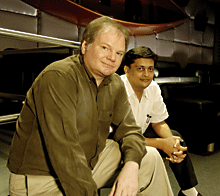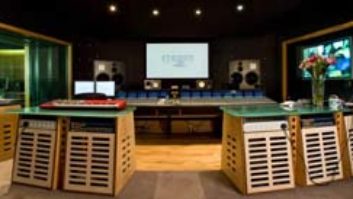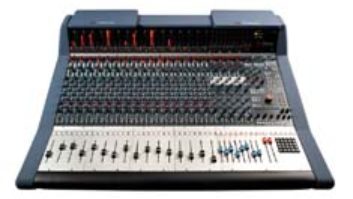

Meet Roger D’Arcy, international man of studio design. The founder of the UK-based firm Recording Architecture (www.aaa-design.com), which is celebrating its 20th anniversary this year, and Black Box Acoustic Conditioning Systems (www.blackbox-design.com), D’Arcy has built up an impressive list of credits since building his first studio, London’s Turnkey Two, in 1984.
Roger D’Arcy (left) with his Mumbai, India–based architect Vishal Shah
Photos: Mojo Working ©2007
While he is still an emerging presence on the U.S. scene, D’Arcy has established himself as one of the most in-demand designers over much of the rest of the globe. Thanks to his sharp ears, flexible acoustic approach and riveting visual sense, he has created high-impact private and commercial spaces for recording, mixing, mastering, post and education in all sorts of locales, from Spain to Saudi Arabia; he also has a quickly growing fan base in the heavy production center of India’s Bollywood. His notable clients include the likes of Abbey Road, EMI Music, Crystalphonic, Optimum Mastering, Annie Lennox, The Cure, David Gray and Lenny Kravitz.
With the move to smaller rooms such as producer-owned studios, music is being produced differently. As a designer, how do you advise your clients when planning these rooms? What do you need to know about the music that will be produced there?
In the control room, the only thing we need to know about the music being produced is whether they’re principally recording for CD music in stereo or discrete 5.1 formats. Whether it’s rock, drum ‘n’ bass — doesn’t matter; what matters is the provision of a live area. Do we provide any live area whatsoever for use of live microphones in the space? One example is Annie Lennox: She’s perfectly content to sing in the control room with a directional mic. But there are also producers who want to record a big, expansive drum set, in which case we have to provide a much higher level of sound isolation and more diffuse open sound.
The biggest misconception people make in vocal booths is to make them far too absorptive at high frequencies. You can’t achieve what you want just by sticking acoustic foam on the walls — you have to pay more attention to lower and high-mids. Sound is fundamentally a pressure wave that is frequency- and wavelength-dependent. At 100 Hz, the wavelength is more than 11 feet long, so sticking a piece of carpet on the wall isn’t going to affect 100 Hz. The danger is that by adding that, you’re disproportionately affecting mid- and high frequencies. You’re almost better off having a uniformly live ambient characteristic than you are having one that is disproportionately dead in the upper-register.
We’ve been dealing with smaller rooms since the outset, often [rooms] for artists. Unfortunately, the areas of cancellation are more pronounced and difficult to get away from in a small room; you’re almost invariably sitting near the middle, and sitting in the middle of any parallel or square shape is no good, so the monitoring position becomes the position of maximum cancellation. Therefore, the smaller the room, the more careful you have to be with your acoustic design. That doesn’t necessarily mean it’s more expensive, but you probably do have to spend more per square foot. People who can do small rooms are the skilled acousticians.

D’Arcy is seeing much work in Mumbai, India, including this private studio for film music composer Amar Mohile.
Do you think these types of rooms are getting better? What advice can you offer to a producer reading this who wants to improve the acoustics, ergonomics or overall quality of his room?
It calls for an in-depth understanding of different techniques. The other thing with small rooms is that the affordability of equipment means that people’s budgets are eaten up. They can buy the equipment, but they haven’t thought of the room acoustics. People are not properly funded to get into the industry in the first place. They’re encouraged to get in when they can afford the equipment, but at the end of the day, if you can’t properly hear what you’re doing, then you may as well work on headphones.
I mix on headphones! I know I shouldn’t, but I also know that even if I have a pair of Genelecs in the room I have to work in, it would still be almost impossible for me to make it accurate.
Purists scoff at headphones, but headphones are better than a bad room, and by “bad room” I include 90 percent of today’s commercial studios. This goes back to trends in room design: Many other designers try to apply one theory as if it’s the sole solution. We’ve seen live-end rooms, dead-end rooms, reflection-free rooms bordering on anechoic and the more current trends, where more particular types of diffusion are used to solve all problems. No one of them on its own will solve all problems across the board on frequency range. It’s a mixture of certain principles: of live- and dead-end, diffusion, some absorption, some reflection-free area.
Your studios definitely have a distinctive look. How does a designer develop his own look, and how does that look impact the environment?

Sound City, Mumbai’s premier film mix facility
My principle background is as an architect and designer, so to me the aesthetics are crucial. They’re important both psychoacoustically and from the point of view that you need a good creative working environment. We don’t just dress up ugly looking acoustics; we try to develop a unified solution that is one expressing the other. Where we started making inroads on that to my satisfaction was UB40’s studio in the late 1980s [see Mix, May 1995 issue], the expression of the acoustics rather than hiding it. So what we try to avoid is just a fabric box. The membranes or absorptive elements that can be developed and expressed, how does a designer develop those? Over years and time, you get different materials and ways of tackling the solution.
How would you describe your aesthetic style?
Our American clients — including Rainmaker, Crystalphonic, and the most outrageous room was probably Magneto Electric Works in Minneapolis — come to us and they say they find our style quirky and European. I understand in a way what they mean. I would say that we just handle form a little differently. We’re not afraid of curve, but a lot of American architecture is very linear and boxy and square. In our construction techniques, we use a much more fluid approach to design, not all straight edge. It leads to a more 1920s European industrial style in origin. And a reasonably bold use of color — we’re not afraid of color.
Why is a visually pleasing environment important to an audio facility?
I would say it’s roundly accepted that comfortable environments are less fatiguing, as are more natural acoustics. Working in an anechoic environment, or one where there are lots of boomy bass frequencies, is actually more fatiguing on the ear. The more natural acoustics and the same visual equivalent are more relaxing and conducive to long periods of hard work. Everyone benefits from daylight. We have introduced daylight for the last 20 years, yet in America we find people still raise an eyebrow and are surprised by that.
What advice do you have for people who want to improve their own rooms’ ergonomics and aesthetics?
The rules are fairly obvious. In smaller spaces, you need absolute left/right structural symmetry more than visual symmetry. A brick wall on the right and window on your left is not good. The problem with small rooms is that it forces people to put speakers far too close to the wall, which has low-frequency implications. So don’t underestimate symmetry. Keep speakers away from the wall if space permits, and hope that position doesn’t force you to sit in the middle between the front and back wall. This is fairly straightforward stuff, but you’d be surprised at how many people don’t deal with it, even when they’re aware that they should.
Tell me about some of the new acoustical solutions that are being developed.
Sound characteristics and the laws of physics have not changed. The way sound behaves when it leaves the speaker and the human ear haven’t changed, so you can only do three things: You can absorb it — either by dealing with the pressure or the velocity component of the sound wave — you can deflect it, hence reflection theories, or you can diffuse it.
All these techniques are to achieve one thing: to make the sound from the speaker itself dominant so you perceive the sound from the speaker and not the sound of the room. But the trick is to do it in as natural-sounding a room as possible. In the old anechoic rooms, they wanted the sound to come out and never come back, but the human ear doesn’t work like that, and the sound absorption techniques in the ’70s and ’80s were not that efficient. They weren’t truly anechoic; they were quasi-anechoic. Been in one? Sounds like you’re going to die.

In addition to numerous private studios, D’Arcy is also working on larger projects, such as this music/dance/cinema auditorium at Whistling Woods Institute for Film, Television and Arts, also in Mumbai.
There’s one other characteristic, which is that there will be a variance in the room caused by floor reflections that you can’t do anything about. But the desired result is to hear the sound of the speaker predominantly over the room, in as natural an environment as possible.
What do you bring to working in so many different countries and cultures, and what do you bring back from them?
We learn that there are many ways to skin a cat! That’s why it’s important for the acoustician or studio engineer to have a repertoire of techniques, not to be locked into one particular theory. Sometimes the materials aren’t available, for example. What we do is try to avoid importing everything, and we go to a lot of trouble to see what materials are available locally. In Bollywood, we’re on our 14th room in five years, and we’ve seen the advantages of this approach starting with cost: It’s unfair to force less-developed countries with weaker economies to import materials, and with skill you can achieve as good, if not better results simply by using intelligence and thinking about the problem rather than applying some standard solution in the environment.
In India, wood is expensive, whereas marble and granite are not. In North America, labor is more expensive, so there’s a tendency to use geometric and square solutions because it’s quick. In India, labor is a fraction of the cost [as compared to] the rest of the world, so you can have a much more fluid approach to your design because you can afford to do it. It also gives you a much more expanded repertoire of ways to color. You learn there’s no such thing as a bad color!
Where’s the growth in your sector of the industry?
In India, it’s film/mix, which includes music for film and composition of music for film. In India, 95 percent of films have songs, and the songs are featured, not just in soundtracks but also as a part of the film. That’s different from anywhere else — the film and music industries are all one.
Indie record companies requiring their own facilities, artists just wanting their own facilities — we’ll have them forever.
Mastering rooms — the more product that’s needed, they have to be quality-controlled somewhere. That’s going to be more and more needed as more music is produced by people on computers in bedrooms. If you need quality control, mastering rooms are actually very accurately designed control rooms.
Why do you enjoy being a studio architect?
I hate it! I’d rather own a bar in Key Largo. [Laughs] It’s a constant challenge. Especially working internationally, we get the opportunity to solve different design problems every day. The nature of the business is that the turnover is very rapid, and we get to see the results of our design labors very quickly. We don’t have to wait years; we get to visit spaces we create usually in a matter of months. That’s very satisfying: Fly to the other side of the world, walk into a room and know what color it’s going to be and what’s behind the door. It’s a weird feeling.
David Weiss is Mix’s New York editor.

WATCH:
More examples of D’Arcy’s studio design work




